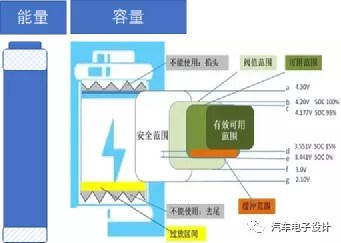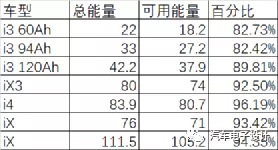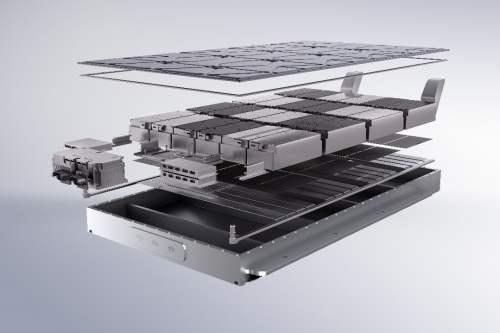Today I would like to talk about some thoughts on the battery management of previous pure electric vehicles when I have time. Overall, from 2017 to 2018, it was the process of the first generation of ternary batteries used in pure electric vehicles in China. For automobile companies, the existing stock of vehicles needs to be continuously maintained, while for battery cell companies, these are already iterated technologies. With the deepening of applications, some considerations need to be made for battery degradation and safety.
Absolute Energy and Net Energy of Battery
When talking about this concept, before explaining the problem, let’s first take a look at the energy of the battery. According to our national standard “GBT 31484-2015 Requirements and Test Methods for the Cycle Life of Power Lithium-ion Batteries for Electric Vehicles”, the energy provided by battery companies is the rated energy, in Wh unit, which is the energy released when a fully charged battery is discharged with 1C current at a temperature of 25℃ until it is lower than the cutoff voltage. In the declaration of vehicle data, it is actually marked according to this rated energy at 1C.
However, this actual energy is not so well controlled. In the battery management system, it is managed according to capacity Ah, and according to State of Charge (SOC), which refers to the percentage of the capacity that can be released under certain discharge conditions in the battery, with the available capacity as the denominator, and the theoretical range of SOC percentage is generally from 0% to 100%. Considering the characteristics of chemical battery reaction: threshold boundary, static and dynamic differences, rate differences, estimation accuracy differences, etc., a buffer interval needs to be reserved for SOC estimation to ensure that the battery works in a safe zone at all times. Therefore, for customers, what can really be used is a range, for example, 5% to 95% to release 90% of the electricity.

In this regard, European automobile companies usually give two data according to their own methods, directly indicating this usage interval. From a technical point of view, as the battery gets larger and larger, there is a critical point from 40-50kWh, and the open interval begins to expand to over 90%.

Starting and Ending BOL and EOL Energy
Electric vehicles also age, and like fuel vehicles, the battery will deteriorate after XX years and XX kilometers in the future.
BOL energy = battery rated energy * SOC window
EOL energy = battery rated energy * SOC window * battery degradationIn this approach, what car manufacturers can do is to provide a relatively long warranty period with a 70% battery capacity retention rate as the basic quality assurance condition, or to use battery safety, as Tesla does, to cover any potential issues. The reality is that for early versions like the i3 with a total battery energy of 22 kWh and an early BOL of 18.2 kWh, as the battery experiences wear and tear, the total available power reaches only 12.74 kWh, which is a real and significant problem. These early model batteries from 2013 have been replaced and upgraded to the 42.2 kWh version.
According to simulation data from Europe, the battery degradation coefficient is around 10% for 3-5 years and 20% for 8-10 years. Under normal conditions, triggering the 70% warranty condition is not likely to happen.
In my discussions about electric vehicle technology GTR at the United Nations EVE, I conducted a comprehensive technical and legislative analysis of battery degradation. The goal is to form a document by June 2021. The core objective is to encourage car manufacturers to provide an intermediate process based on actual years and mileage, rather than a 70% rate. By the time this document is formed, most car manufacturers are expected to have a more suitable degradation coefficient.
The most concerning issue is related to safety controls and balanced usage strategies. Two American companies have mitigated safety issues by setting maximum voltage or SOC. In reality, this is mainly due to SOC estimation and calibration in low-current charging control using voltage calibration. From a safety statistics perspective, high SOC states are prone to thermal runaway. There are two ways to address this:
-
Force the maximum SOC setting in the BMS (GM has released an update that does this, setting it to 90%).
-
Set the recommended SOC range (maximum 90%) in the central control screen system and default to it each time, changing it to the desired value only during long-distance travel.
Summary:My personal opinion is that in the development of electric vehicles, we have seen the replacement of batteries from several tens of Ah to 200 or even 300Ah. We have also seen the development of batteries from 30kWh to 100kWh, and the resulting mileage has become longer and longer. During the development stage, compared to the past 2-3 years, batteries were more expensive and had lower energy density. This is also the driving force for the development of batteries towards a battery pack, which can be replaced and upgraded, meeting the practical needs of users.
This article is a translation by ChatGPT of a Chinese report from 42HOW. If you have any questions about it, please email bd@42how.com.
